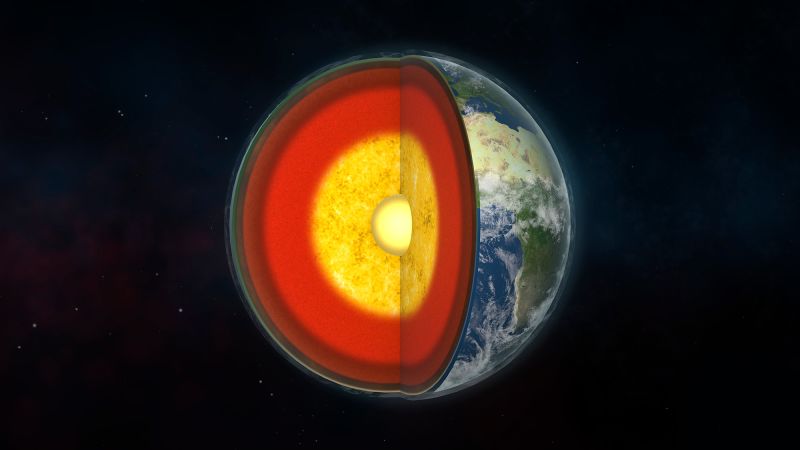Sign up for CNN’s Wonder Theory science newsletter and immerse yourself in the latest discoveries and advancements in science that explore the mysteries of the universe.
Like humanity itself, our planet, Earth, harbors a complex and often hidden activity beneath its surface; this may particularly be true of what has long been considered its most straightforward layer, the mantle. The mantle, residing between the planet’s thin crust and its molten core, comprises approximately 1,800 miles (about 2,900 kilometers) of predominantly solid rock, comparable in consistency to thickened caramel. For a long time, scientists hypothesized that this layer was a homogeneous mixture. However, recent studies have uncovered massive unmixed regions within the mantle, likened to lumps of chocolate in a cookie, which are providing new insights into our planet’s geological mysteries.
Among these intriguing mantle formations are significant “supercontinents” located deep beneath the Earth’s surface, buried thousands of kilometers below the crust among remnants of ancient tectonic plates. Notably, one supercontinent has been identified beneath Africa, while another resides deep under the Pacific Ocean. Researchers employing innovative techniques to analyze seismic data from earthquakes have revealed essential details about these colossal regions. Their findings suggest that these supercontinents could be anchoring points within the mantle and are potentially much older than previously assumed.
This discovery aligns with a growing body of evidence that indicates the rocky mantle may not be as homogenously mixed as once believed. These hidden structures, such as the aforementioned supercontinents, may influence mantle behaviors, including the movement of tectonic plates, in ways that remain poorly understood. Claire Richardson, a doctoral candidate at Arizona State University, noted that these findings would enhance our understanding of mantle convection and plate tectonics, affecting surface phenomena like earthquakes and volcanic activity.
The challenge of understanding the mantle rests in its extreme conditions, with rocks situated around 3,000 kilometers deep experiencing high pressures and temperatures. As early as 50 years ago, the subterranean supercontinents were initially detected as anomalies in seismic data, where earthquake-generated seismic waves would reveal changes in wave speed as they traversed through the mantle. Over the years, research identified that these supercontinents account for approximately 20% of the mantle-core boundary, each covering vast expanses and at times rising nearly 600 miles (965 kilometers) high. However, significant questions regarding their composition and influences on mantle dynamics remained elusive.
Past studies measured seismic wave velocities, demonstrating a slowdown of about 2% when these waves encountered the supercontinents. These regions were designated as large low shear velocity provinces (LLSVPs). The delay suggested that the temperature in these areas was higher than around the neighboring rocks, yet the exact structural variations remained uncertain. Researchers were unsure whether these supercontinents played a role in convective activity or if they simply constituted dense amassed rock.
The recent study initiated a different inquiry into the LLSVPs, emphasizing the attenuation of seismic signals, which gauges the loss of energy as seismic waves travel through various materials. By employing a new method, researchers hypothesized that differences in damping could unearth vital insights about the composition and activity of these regions. In this approach, the focus pivoted to understanding the interaction of seismic waves with rock grain sizes and temperature, shedding light on the mantle’s intricate physical properties.
The results indicated that while seismic waves slow down when reaching LLSVPs, they do not experience substantial energy loss, contrasting significantly with the damping observed in the cooler regions surrounding them, known colloquially as “slab graveyards.” This discrepancy likely arises from varying ages of the geological features. The study suggested that younger regions, having more compacted grains, absorb more energy, indicating that the LLSVPs were potentially much older, composed of larger mineral grains.
These findings propose that the LLSVPs are not merely temporary geological features but possibly long-lived elements in Earth’s geology, existing for hundreds of millions of years, adding a robust dimension to our understanding of Earth’s mantle dynamics. Additionally, new revelations about tectonic plate remnants indicate the presence of submerged regions that contradict earlier perceptions, pointing to the complexity and intricate nature of Earth’s internal structures.
Ultimately, this pioneering study, creating the first 3D attenuation model of the entire mantle, could significantly alter seismologists’ understanding of the phenomena at play thousands of kilometers beneath our feet. Addressing questions that have historically perplexed scientists, this research opens avenues for investigating whether these supercontinents might serve as reservoirs for primordial geochemical elements, thereby deepening the comprehension of Earth’s geological evolution.



